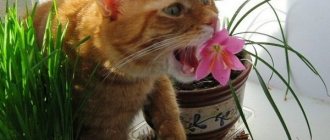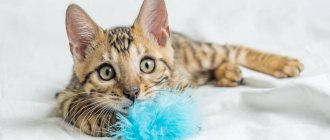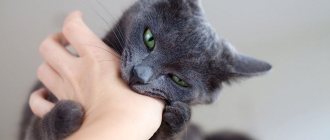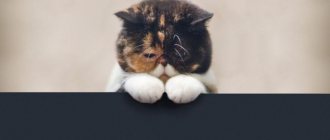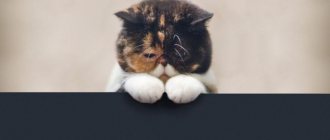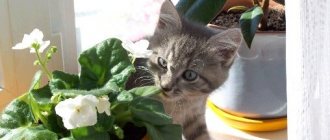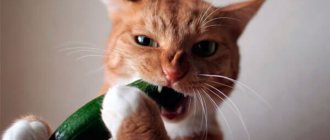| Article verified by a practicing veterinarian |
Many owners of furry pets tend to believe that a cat is a liquid.
How else to explain their phenomenal ability to fit into jars, saucepans and other small containers. And even though such pranks cause affection among good-natured owners, there are things that need to be stopped. For example, walking on the table. Everyone is already accustomed to the fact that cat hair is a home insulation and a special type of spice. But dirty paws , which may have been in the potty before, can bring a lot of pathogenic microorganisms onto the table, which is already dangerous for two-legged members of the family.
In this article we will talk about how to wean a cat from climbing on the table, the reasons for this phenomenon, the possible consequences for your four-legged pet, and methods of dealing with harmful behavior using humane methods.
Reasons for deviant behavior
We love our pets with all our hearts, but we must admit that the squad of furry domestic terrorists should be divided into subcategories:
- Caressing cat;
- Thief cat;
- Taskmaster Cat;
- Tracker cat;
- Frozen cat;
- The cat is an ordinary cat.
We need this to establish the reason that prompts the cat to climb onto the table, and to choose a method for correcting the situation.
Why does the cat climb on the table? 6 reasons
Wants attention
A common situation is that a child is doing homework, and the cat lays down on notebooks, books, and throws off pens and pencils. Or you are working at the computer and a furry one lies down on the keyboard and tries to climb onto the monitor. All these are ways to attract attention , the same can be an attempt to climb onto a table.
Hunting
Even an empty table retains the smells of food, which arouses the cat’s interest. Despite the presence of food in the bowl, the cat will probably want to try your food too, in case it tastes better and contains more meat. And who can resist the opportunity to “get” a piece of delicacy with a clawed paw from under the nose of an inattentive owner. The presence of food near the edge of the table is perceived by cats as a challenge to their hunting instincts .
Monitoring the situation
In nature, representatives of the cat family prefer to rest and look out for a future meal from above . Domestic cats do not have an urgent need to rest in a safe place and hunt, but the climbing instinct is also present. A table is a great place from which to look around a room or kitchen. That's why climbing on it is the duty of every decent cat.
Curiosity.
This is especially true for small kittens, who need to explore every object, sniff everything, taste it and play.
Cold
Despite the presence of fur, cats in the house also freeze . Most often due to the presence of drafts on the floor, which a person may not notice. Therefore, the cat can choose the table as a warm place.
Special temperament
Some cats believe that they are the masters of the house. Therefore, they dictate the rules of behavior for their two-legged cohabitants.
Preventive measures
Everything ingenious is simple - if your cat makes periodic pilgrimages to the table for food, if possible, remove all treats from their reach. Leftover sausage or smoked fish can attract the attention of even a well-fed, happy pet. Strong odors will simply oblige your pet to go scouting.
The absence of objects on the table will significantly reduce the cat's interest
One of the possible reasons for a cat's love for kitchen surfaces is malnutrition. Sometimes the owner simply does not put enough food into the bowl; sometimes the composition of this food does not provide a sufficient amount of nutrients.
If you “pamper” your pet with food from the supermarket, get ready for frequent bursts of appetite. Cheap food is an analogue of human fast food - they lull hunger only for a couple of hours, being useless dummies.
The sooner the cat learns the word “no,” the better the life together will be.
Remember that the tricks that will be described above can be avoided if you start raising a pet from an early age. The “no” command must be learned by every pet. The sooner the kitten gets used to the fact that the owner’s word is law, the easier it will be to interact with him in the future. Of course, cats cannot be trained like dogs. But they are able to pick up human intonations and assimilate the desired reaction from them.
Should I stop my cat from walking on the table? What is the danger?
The question of how to wean a cat from climbing on the table is important from the point of view of hygiene and safety not only for you, but also for the pet itself.
What can result from negligence on the part of a person in this matter:
1. Infections and parasites
Cats, unlike people, do not wash their paws . In addition, cats with access to the street do not hesitate to hunt for mice or birds. While eating, a person can put, for example, bread on the table where a cat had previously walked, and introduce dangerous microorganisms into his body.
Animal injuries
Animal injuries. There are often objects on the table that are dangerous to play with. Injury can also occur when trying to climb onto the table using the tablecloth, thereby knocking something heavy over yourself.
Products dangerous for cats
Humans and representatives of the animal world have completely different dietary needs, and products that a person consumes without consequences for himself can cause allergies in a furry friend, and in advanced cases, serious disorders of the liver, gastrointestinal tract, and pancreas.
Violation of discipline
Relaxation on one issue will inevitably lead to other violations of the rules of cohabitation.
What is not recommended to do?
If, despite everything, you want to maintain a warm relationship with your beloved pet, then you should not resort to overly harsh measures. When getting rid of your cat’s bad habits, it is not recommended to:
- deprive the animal of the opportunity to drink and eat;
- resort to physical measures of education;
- deprive the animal of the opportunity to communicate with you;
- shout loudly at your pet.
Remember that your pet does not consider his actions to be bad. He believes that climbing on the table is quite normal. Consistently, regularly and loyally, weaning your cat from this unpleasant habit, you will not only achieve what you want, but also maintain a trusting relationship with your furry friend.
Love your pet, don’t offend him, and he will repay you with his boundless love and devotion!
Method 1. Use the latest gadgets
How to stop a cat from walking on the table if you don’t have time to watch it all day? You can try to use technological innovations, the creators of which have already taken care of everything. For example, there are special vibrating mats, air cannons with a motion sensor, and robot repellers .
Vibromats
To use a vibrating mat, you will have to fill almost the entire surface of the table with objects and leave a small free space for the device. When the cat tries to climb, the mat turns on and begins to vibrate . As a result, the cat gets really scared when things start to buzz and vibrate under its paws, and loses interest in the scary place.
Ultrasonic robots
The CatNani robot moves independently on the table, recognizing the edges of the tabletop. When a cat tries to climb onto a prohibited surface, the robot fires a “warning” ultrasound shot .
Robot Catnani
If the cat did not understand the first time, then the robot fills the territory entrusted to its protection with a citrus aroma . But this method can also have a negative result - the cat can throw the annoying car off the table and calmly climb to where it needs to be.
Robots that shoot compressed air
The ARGUS protection device has a motion sensor. When the cat tries to pass by, he will shoot compressed air . The sensor's coverage angle is quite wide and it will respond not only to the cat, but also to all household members within its reach. Therefore, it is advisable to turn on this unit during periods of absence of owners near the territory protected from the cat.
You will have to buy spare cans as needed, so those who are thrifty will not like the idea. But according to animal psychologists, this is one of the most successful options for solving the problem.
What not to do
When you see a cat climbing on tables, you should not rush to scream and run away with punishment. First of all, you need to understand that cats do not perceive human methods of influence the same way as people do. A person is able to distinguish between the correctness of his action and more than a thousand different intonations in the voice of his interlocutor.
Cats cannot do this, so their reaction to swearing and assault will be different. They will not understand why they are being shouted at, and, moreover, why they are being beaten - cats do not always recognize being on certain furniture as something bad. They do not know that they have committed a crime, and they may become offended, angry and do something out of spite. A cat that is softer in character may begin to be afraid of people.
Methods that are not suitable for the cat’s breed or character are unacceptable. There are individuals that are more sensitive to noise, and it is very easy to scare them excessively. The same goes for kittens of any breed.
Each of the weaning methods needs to be considered more closely. For example, some cats love water very much, and it will only draw even more attention to the table. On the other hand, water can frighten a cat, and stress in the animal will not be long in coming.
Negative examples include a rug that shocks. It will, of course, scare the pet away from the table, but the consequences can be unpleasant, and there can be no question of humanity. There is a good alternative - a vibration mat that will gently and without unnecessary stress discourage your cat from the table and other unwanted places. There are varieties with sound signals that are better for the cat.
The moment when a cat climbs on tables can be compared to a bad habit in humans. It’s difficult to get rid of it, but you can “replace” one habit with another: it’s ideal if you can replace a bad habit with a useful one. For example, sitting on a chair next to the owner.
Method 3. Rearrange the furniture
If the cause of the chaos is the cat’s inability to get to the right place by other means, then it would be more logical to clear the way for him. Most often, due to the natural characteristics of the cat family, cats need to monitor the situation on the street from the window . Therefore, if there is a table on the way to it, the cat can climb on it.
A table by the window will attract a cat like a magnet, because there are so many interesting things happening outside the window.
Method 4: Use a spray bottle of water, but with caution
Suitable for animals that do not really like water, but are not afraid of it either. Otherwise:
- may be perceived as a game if the cat really likes to swim;
- It may be difficult to wash the animal in the future if the cat gets very stressed.
The method consists of spraying the animal with a spray bottle when it tries to jump onto the table or when it is in the wrong place.
Folk remedies
The most popular folk remedy is vinegar. It is diluted in a 1:1 ratio and the area where the animal shits is washed. It not only removes unpleasant odors, but also repels the pet. Some people prefer to use bleach or bleach. But, firstly, not all mustaches are repelled by this smell. Secondly, for people living in an apartment, frequent use of bleach is unlikely to be beneficial, especially for children.
A weak solution of potassium permanganate, iodine solution (a few drops per liter of water), and hydrogen peroxide are suitable for disinfection. A paste of baking soda and water removes odor well, and after drying it can be easily swept up or removed with a vacuum cleaner.
Method 6. Pay attention to education in childhood
Education from early childhood . Kids quickly get used to everything new and learn. Any attempt to jump on the table must be stopped. Usually it is enough to knock loudly on the table on which the attack is being made. If you see that the kitten is getting ready to jump (before the jump, cats gather into a spring and try on), you can pick it up and move it to another room. If you have already jumped, knock on the table and remove the cat.
Method 8: Use double-sided tape, but only under supervision
For these purposes, you can choose regular office double-sided tape, but there is a better option. There are special double-sided adhesive tapes that protect against cats. For example, Sticky Paws.
They work like this: when the cat decides to jump on the table, its paws will stick, and these sensations are very unpleasant for cats . As a result, the fluffy one will jump off and try not to repeat the mistakes again.
This method is not suitable for long-haired cats , because... the glued wool will have to be cut off. The cat may also get scared and begin to behave unpredictably. This risks the fact that he may become entangled in the tape or eat it while trying to free himself. Therefore, this method is only good under human supervision.
Method 9. Use foil, but very carefully
After the furry lawless creature tries to jump on the table, his paws will begin to slip, and the foil will rustle disgustingly. Cats don't like .
To prevent traumatic situations, this method is carried out only under human supervision . Having slipped, the cat may fall unsuccessfully, may begin to show interest in the foil and try to eat it. If you notice that the animal is playing with the foil, it is better to remove it altogether and use another method.
Method 10. Set up a room or kitchen with climbing areas
Climbing to high places is one of the cat's instincts . If it is not possible to climb on them, a table is used. That is why, to satisfy the need for climbing, it is worth purchasing various vertical houses and scratching posts or equipping a play area for the cat yourself (all sorts of ropes, beds, pipes, and so on). With this alternative, the cat can easily forget the way to the kitchen table, which means our mission is completed.
Unexpected fall
The method is somewhat inhumane, but one session may be enough for the cat to forget the way to the table. To carry out the plan, you will need a lightweight plastic tray.
The tabletop is furnished with “inconvenient” objects so that only one side remains free. Bottles and pots will come in handy as an impromptu fence. Place the tray on the free side, pushing it slightly beyond the edge of the tabletop. You can pour some water into the tray itself.
Further events can be predicted. The cat doesn't want to jump on the tray, but there is no choice, because the whole table is occupied. The animal jumps, knocking over the tray. Water pours onto the cat, and the container itself falls to the floor with a crash.
After such a procedure, the pet will not dare to explore the table for a long time. For greater effect, the grief tray can be left in sight for several days.
